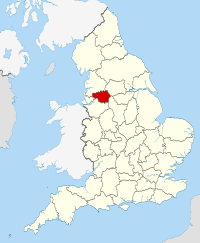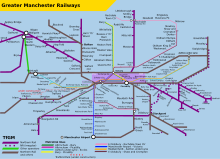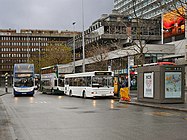 | |
 Map showing Greater Manchester, the executive's area of responsibility Map showing Greater Manchester, the executive's area of responsibility | |
| Abbreviation | TfGM |
|---|---|
| Predecessor | Greater Manchester Passenger Transport Executive |
| Formation | 1 April 2011; 13 years ago (2011-04-01) |
| Type | Public body |
| Purpose | Transport authority |
| Headquarters | 2 Piccadilly Place Manchester M1 3BG |
| Region served | Greater Manchester parts of Derbyshire, Cheshire and Lancashire |
| Commissioner | Vernon Everitt |
| Managing Director | Steve Warrener |
| Parent organisation | Greater Manchester Combined Authority (GMCA) |
| Budget | £330.6m |
| Website | www |
Transport for Greater Manchester (TfGM) is a local government body responsible for co-ordinating transport services throughout Greater Manchester in North West England. It is an executive arm of the Greater Manchester Combined Authority (GMCA), the city region's administrative authority. The strategies and policies of Transport for Greater Manchester are set by the GMCA and its Greater Manchester Transport Committee (GMTC). The committee is made up of 33 councillors appointed from the ten Greater Manchester boroughs (Bolton, Bury, Manchester, Oldham, Rochdale, Salford, Stockport, Tameside, Trafford and Wigan), as well as the Mayor of Greater Manchester.
TfGM owns Metrolink – the United Kingdom’s largest light rail network – which is operated and maintained under contract by a Keolis/Amey consortium. TfGM also owns Greater Manchester's Cycle Hire scheme, and is responsible for cycling and walking infrastructure. TfGM owns and maintains bus stations, stops & shelters, however bus services are deregulated in Great Britain outside London. Following the passing of the Bus Services Act 2017, Greater Manchester became the first city-region to start the process of bus franchising, returning bus services to public control. TfGM does not control National Rail services or infrastructure in Greater Manchester.
TfGM is responsible for developing the Bee Network, an integrated transport network for Greater Manchester. The Bee Network is proposed to include a single transport livery, integrated fares & ticketing, and a fare cap across tram, bus, cycling, walking, and eventually suburban rail. By 2025, Metrolink trams, franchised buses services, and cycle hire are planned to be integrated. Negotiations with central government are ongoing for some commuter rail services to join the network, starting from 2025.
History
The organisation traces its origins to the Transport Act 1968, when the SELNEC (South East Lancashire/North East Cheshire) Passenger Transport Executive was established to co-ordinate public transport in and around Manchester. Between 1974 and 2011, it was known as the Greater Manchester Passenger Transport Executive (GMPTE), until a reform of local government in Greater Manchester granted it more powers and prompted a corporate rebranding. On 1 April 2011, the GMPTE became Transport for Greater Manchester (TfGM), a new regional transport body for Greater Manchester that forms part of the new Greater Manchester Combined Authority (GMCA).
Governance
See also: Greater Manchester Combined Authority § Bee Network CommitteeTfGM inherited the responsibilities of the Greater Manchester Passenger Transport Executive established in 1974. At the same time the Greater Manchester Integrated Transport Authority (GMITA) was abolished, with responsibility for oversight of the executive transferred to the combined authority.
The combined authority and the ten Greater Manchester districts have delegated or referred most of their transport governance functions to a joint committee, the Bee Network Committee. Each local authority appoints one of its executive members with responsibility for transport matters to sit alongside the mayor, a member of the GMCA, and up to four other councillors appointed by the mayor. These additional mayoral appointees allow the committee's political make-up to reflect the political make-up of Greater Manchester's councils as a whole.
The Bee Network Committee has four key responsibilities: Decision-making over significant operational matters across the transport network (including the ability to draw down funding for investment), monitoring the performance and financial stability of the network, developing policy to support the local transport plan, and facilitating coordination between the ten local authorities around highways maintenance and infrastructure delivery.
Services

Manchester Metrolink
Main article: Manchester MetrolinkThe Manchester Metrolink light rail/tram system launched in 1992, entirely subsidised by TfGM without a government grant and operated by KeolisAmey. It carried 43.7 million passengers in the 2018/19 financial year. With 99 tram stops, it is the second largest local transport network in the United Kingdom after the London Underground. Further expansion of the network to places like Stockport and Bolton are envisaged.
- Altrincham – Piccadilly (extends to Etihad Campus Mon–Sat evenings and all day Sunday)
- Ashton-under-Lyne – Eccles (via MediaCityUK outside Mon–Sat daytime hours)
- Bury – Piccadilly
- East Didsbury – Rochdale Town Centre
- The Trafford Centre – Deansgate-Castlefield
- Manchester Airport – Victoria
- Altrincham – Bury (operates Mon–Sat daytime)
- Etihad Campus – MediaCityUK (operates Mon–Sat daytime)
- East Didsbury – Shaw and Crompton (operates Mon–Sat daytime)
Rail services
Rail services are operated by Avanti West Coast, CrossCountry, East Midlands Railway, Northern, TransPennine Express and Transport for Wales. TfGM subsidise fares on certain local services and fund station refurbishments on an ad hoc basis.
Buses
- Free Bus and Metroshuttle: launched 2002, free bus service around Manchester city centre. New services were provided in Bolton, Oldham and Stockport after success of the service in Manchester.
- Bus services operated by private operators including Arriva North West, Bullocks Coaches, D&G Bus, Diamond Bus North West, First Greater Manchester, First West Yorkshire, Go North West, Rosso, Stagecoach Manchester & Vision Bus
- Maintenance of bus shelters and stations including Shudehill Interchange
- Ring & Ride – An accessible, low-cost minibus service for people who have difficulty in using public transport
Highways and cycling
- Greater Manchester Urban Traffic Control Unit (GMUTC) – responsibility for road management transferred to TfGM in 2009. Entails installation, maintenance and management of traffic signals, limited areas of road safety (2012), incident response and event management via a traffic control centre.
- Cycling – promotion of the Greater Manchester Cycling Strategy and delivery of Cycle Hubs and regional cycle routes
Fares, ticketing and information
- Subsidised fares on certain services
- System One travelcards
- Get me there
- Public transport maps and timetables
- Website
- Route Explorer application
-
 Manchester Metrolink
Manchester Metrolink
TfGM owns Greater Manchester's light rail system, which includes over 64 miles of track and 99 stops across seven of the ten Greater Manchester boroughs. -
 Free bus
Free bus
TfGM owns the free bus service around Manchester city centre. -
Commuter rail services
Commuter rail services are provided by train operating companies (TOCs). TfGM subsidises local rail services and helps to fund station improvements across Greater Manchester. -
 Bus services
Bus services
Bus services in Greater Manchester are deregulated. TfGM owns and maintains bus stations, stops & shelters. It implements the System One multi-operator and multi-modal travelcards, and subsidises some fares, however this is being reversed by the new Bee Network, with the network being brought back under local control, with TfGM appointing franchisees to operate the services. -
 Road management
Road management
TfGM is responsible for managing the Key Route Network of major roads, as well as maintenance of traffic signals.
Bee Network
Main article: Bee Network See also: Symbols of Manchester § Worker beeThe Bee Network is a proposed integrated transport network for Greater Manchester, composed of bus, tram, cycling, and walking routes. TfGM's vision is for the network to be operational by 2024, with commuter rail services joining the network by 2030.
Originally devised in 2018 as a network of active travel routes, the vision for the Bee Network was expanded following the Greater Manchester Combined Authority's decision to use the powers given to it under the Bus Services Act 2017 to introduce a bus franchising scheme for the city region. A fleet of buses were branded and repainted yellow for this in 2024. The active travel subset of the Bee Network was then renamed the Bee Active Network.
Greater Manchester is set to invest a further £40.7m in its walking, wheeling and cycling infrastructure as it progresses with its delivery of the largest active travel network in the country. The £23.7m has been allocated to 13 schemes in total, including a new active travel corridor along Chapel Street in Salford and a striking cycling and walking ‘helix ramp’ as part of the new Stockport Interchange.
Corporate identity

TfGM uses a corporate identity designed in-house. The black and white "M" logo is adapted from the GMPTE logo and is used on bus stops across Greater Manchester.
See also
References
- "New Greater Manchester Transport Committee meets for the first time". tfgm.com. Transport for Greater Manchester. 6 August 2019. Archived from the original on 19 February 2022. Retrieved 19 February 2022.
- "Salford Infrastructure Delivery Plan" (PDF). Salford City Council. February 2012. Archived from the original (PDF) on 20 May 2013. Retrieved 22 January 2013.
- "RATP buys Manchester Metrolink operator". Railway Gazette International. London. 2 August 2011. Archived from the original on 17 September 2011. Retrieved 2 August 2011.
- Burnham, Andy (13 December 2017). Mayor sets out major transport overhaul (Speech). Urban Transport Group. Leeds. Retrieved 12 December 2021.
- "Greater Manchester appoints first bus operators for new system". BBC News. 23 December 2022. Retrieved 30 December 2022.
- ^ "Details of the first buses under public control in Greater Manchester revealed". Manchester Evening News. 23 December 2022. Retrieved 30 December 2022.
- All change: Greater Manchester Passenger Transport Executive becomes Transport for Greater Manchester – with a new logo of course Archived 4 April 2011 at the Wayback Machine Manchester Evening News 1 April 2011
- "Arrangements for Establishing the Combined Authority" (PDF). Association of Greater Manchester Authorities (AGMA). p. 4. Retrieved 8 February 2011.
- "Draft LTP3 Consultation Proposals". Greater Manchester Integrated Transport Authority (GMITA). p. 9. Retrieved 3 December 2010.
- "City Region Pilot and Governance" (PDF). Manchester City Council. p. 14. Retrieved 3 December 2010.
- "Greater Manchester Local Enterprise Partnership – A Proposal To Government" (PDF). Association of Greater Manchester Authorities (AGMA). p. 18. Retrieved 3 December 2010.
- "The Greater Manchester Combined Authority Order 2011: Article 6", legislation.gov.uk, The National Archives, 22 March 2011, SI 2011/908 (art. 6), retrieved 8 August 2023
- "Bee Network Committee – Terms of Reference". Greater Manchester Combined Authority. 31 July 2023. Archived from the original on 1 June 2023. Retrieved 7 August 2023.
- RATP buys Manchester Metrolink operator Railway Gazette International 2 August 2011
- Light Rail and Tram Statistics: England 2018/19 Department for Transport (Retrieved 26 July 2020)
- Operators Transport for Greater Manchester
- Metroshuttle Archived 2 November 2012 at the Wayback Machine Transport for Greater Manchester
- Bus Operators Transport for Greater Manchester
- "Destination: Bee Network". Transport for Greater Manchester. Retrieved 24 April 2022.
- "Bee Network - Greater Manchester's cycling and walking infrastructure proposal" (PDF). Retrieved 24 April 2022.
- Fifield, Jack (14 February 2022). "WATCH: What is the Bee Network?". Retrieved 24 April 2022.
- "Greater Manchester: Bee Network bus rebrand cost more than £500k". BBC. Retrieved 11 July 2024.
- "MCF Financial Approvals and Active Travel Funding Additions" (PDF). 27 May 2022. Retrieved 28 May 2022.
The fund is being used to deliver the first phase of the Bee Active Network, which is the walking and cycling element of the wider Bee Network
- "Greater Manchester to invest a further £40.7m in walking, wheeling and cycling infrastructure".
External links
- [REDACTED] Media related to SELNEC at Wikimedia Commons
- [REDACTED] Media related to Transport for Greater Manchester at Wikimedia Commons
- Official website of Transport for Greater Manchester
- Greater Manchester Integrated Transport Authority
- Greater Manchester Transportation Unit
- SELNEC plans for urban rapid transport
- Greater Manchester Congestion Charge Proposals
- The SELNEC Preservation Society
| Transport in Greater Manchester | |||||||
|---|---|---|---|---|---|---|---|
| Air |  | ||||||
| Bus | |||||||
| Road | |||||||
| Tram | |||||||
| Cycle | |||||||
| Rail |
| ||||||
| TIF bid | |||||||
| |||||||
| Passenger transport executives in the United Kingdom | |||||
|---|---|---|---|---|---|
| Current |
| ||||
| Former |
| ||||